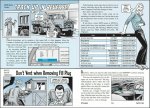- 3,286
- 1,212
- 113
- Location
- The actual midwest, NM.
Alright, so I recently bought an M936A1 and have been trying to read up on what makes those things tick. It'll primarily be used to move a few things around, such as containers, and also to get my FLU 419s unstuck as needed.
It wouldn't surprise me if I get volunteered to get other people's stuff unstuck at some point in the future. Things that are too large and heavy for a regular vehicle or even a winch equipped FLU419 to handle. I doubt I'll ever drive it more than 10 miles (one way) on the road.
Anyway, what I could really use some guidance about is what I absolutely shouldn't do when it first gets here. It'll most likely be me driving it off the trailer, and then down the driveway. And there's no way I won't be trying to operate the crane since now the fluids will be somewhat warm by the time it gets to the garage.
I'm fully aware that none of these machines are idiot proof, and I'm a pretty good idiot, so that's why I ask for advice. Thanks in advance.
It wouldn't surprise me if I get volunteered to get other people's stuff unstuck at some point in the future. Things that are too large and heavy for a regular vehicle or even a winch equipped FLU419 to handle. I doubt I'll ever drive it more than 10 miles (one way) on the road.
Anyway, what I could really use some guidance about is what I absolutely shouldn't do when it first gets here. It'll most likely be me driving it off the trailer, and then down the driveway. And there's no way I won't be trying to operate the crane since now the fluids will be somewhat warm by the time it gets to the garage.
I'm fully aware that none of these machines are idiot proof, and I'm a pretty good idiot, so that's why I ask for advice. Thanks in advance.




